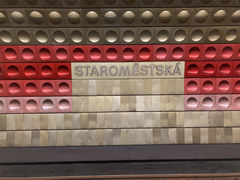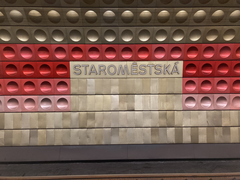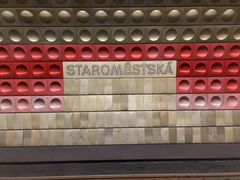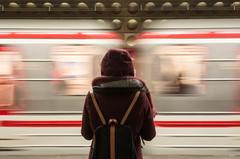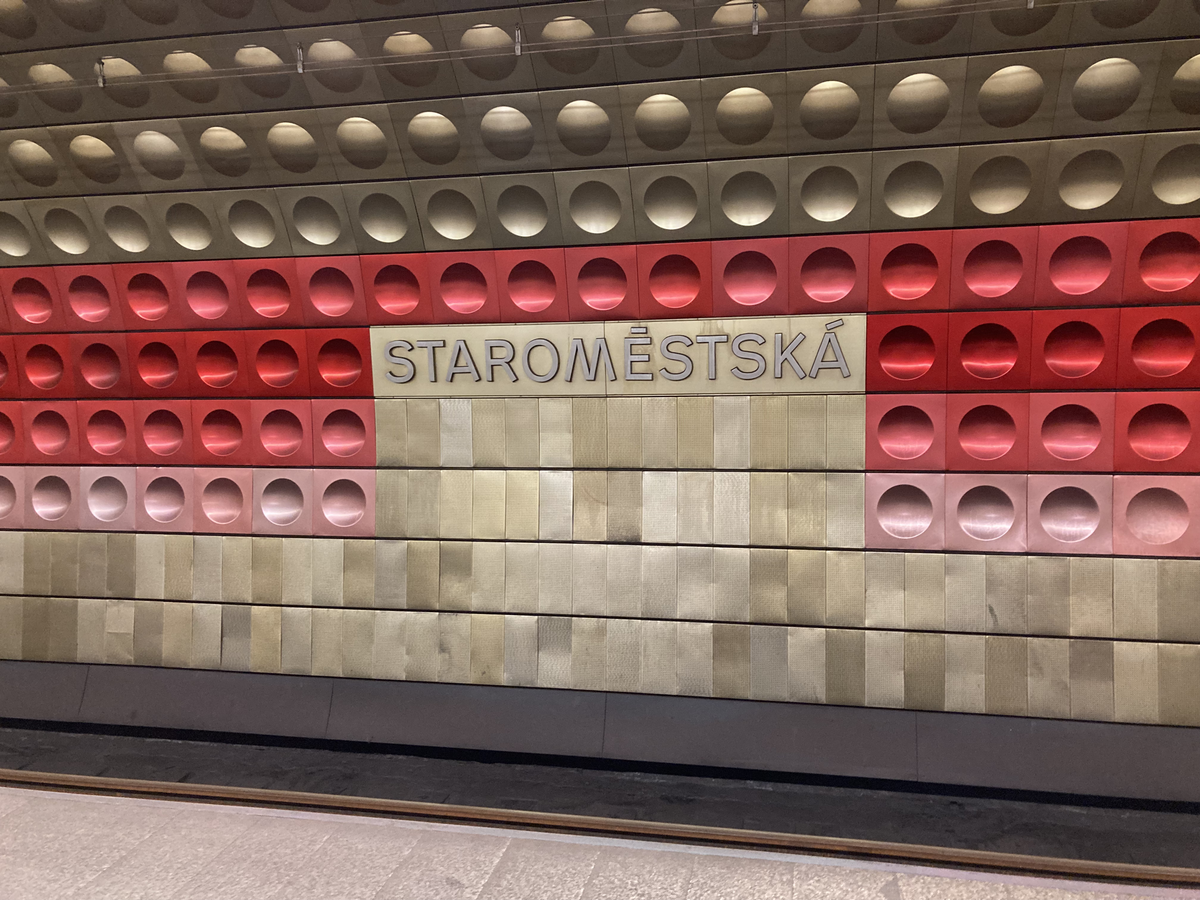
Staroměstská Prague: Visiting Hours, Tickets, and Historical Sites Guide
Date: 14/06/2025
Introduction
Staroměstská, located in the heart of Prague’s Old Town (Staré Město), is a captivating district where centuries of European history unfold through stunning architecture, vibrant cultural traditions, and pivotal historical events. With its iconic landmarks—such as the Old Town Hall, the Astronomical Clock, the Church of Our Lady before Týn, and the Powder Gate—Staroměstská offers visitors an immersive journey into Prague’s medieval, Renaissance, and Baroque past (Introducing Prague; Nomads Travel Guide). The area’s preserved medieval street layout, cultural events, and central location make it both a living museum and a vibrant social hub.
This comprehensive guide provides historical context, practical information on visiting hours and ticketing, accessibility tips, and recommendations for exploring Staroměstská and nearby Old Town attractions.
Table of Contents
- Introduction
- Medieval Foundations and Urban Growth
- The Golden Age: 14th–15th Centuries
- Political and Religious Upheaval
- Baroque Renewal and Cultural Flourishing
- 19th and Early 20th Century: Modernization and National Awakening
- World War II and the Prague Uprising
- The Velvet Revolution and Contemporary Significance
- Visiting Staroměstská: Practical Information
- Exploring Staroměstská and Prague Old Town: Key Sites and Transport
- Insider Tips and FAQ
- Conclusion and Recommendations
- References
Medieval Foundations and Urban Growth
Staroměstská’s roots trace back to the 11th and 12th centuries, when settlements began to cluster east of the Vltava River. Merchants and artisans were drawn by the bustling Prague market, leading to the establishment of diverse communities (Introducing Prague). By the 13th century, the area was unified through the construction of defensive walls, officially founding the Old Town after 1230 (Prague.fm). This legal and structural consolidation positioned the area as one of Europe’s largest and wealthiest urban centers.
The medieval city walls and the later foundation of the New Town (Nové Město) in 1348 limited expansion, resulting in the preservation of Old Town’s distinctive medieval street grid (Prague.fm).
The Golden Age: 14th–15th Centuries
The reign of Emperor Charles IV in the 14th century marked a peak in Old Town’s development. Charles envisioned Prague as the capital of the Holy Roman Empire, commissioning major projects such as the Charles Bridge and the Old Town Hall (Nomads Travel Guide). The Old Town Hall, founded in 1338, became the center of civic administration, while the installation of the Astronomical Clock in 1410 established the area as a center for innovation and artistry (History Tools; Prague.org).
Political and Religious Upheaval
The 15th and 16th centuries brought intense religious and political conflicts. Staroměstská was a focal point during the Hussite Wars, sparked by reformer Jan Hus, with the Old Town Hall witnessing critical debates and negotiations. The infamous Defenestrations of Prague—acts of political violence where officials were thrown from windows—occurred in this era, influencing Czech and European history (Nomads Travel Guide).
Baroque Renewal and Cultural Flourishing
Despite setbacks from wars and fires, the Old Town’s fortunes revived during the Baroque era of the 17th and 18th centuries. Gothic buildings were renovated with Baroque elements, and the area evolved into a center for residential life and culture, even as its political clout diminished (Nomads Travel Guide; Prague.fm).
19th and Early 20th Century: Modernization and National Awakening
The 19th century saw waves of modernization and the rise of Czech national consciousness. Old Town Square became a gathering place for public demonstrations and cultural events. The execution of 27 Czech leaders in 1621, following the Battle of White Mountain, is commemorated on the square (Nomads Travel Guide). The area’s architecture diversified, incorporating Neo-Gothic and Art Nouveau styles (PragueGo).
World War II and the Prague Uprising
World War II left deep scars on Old Town. The Prague Uprising in May 1945 resulted in significant damage to the Old Town Hall and the Astronomical Clock (Prague.eu). Restoration efforts post-war symbolized the city’s resilience and dedication to preserving its cultural legacy (History Tools; Prague.org).
The Velvet Revolution and Contemporary Significance
During the Velvet Revolution of 1989, Old Town Square became the epicenter for mass protests and celebrations that ended communist rule in Czechoslovakia (Nomads Travel Guide). Today, Staroměstská remains Prague’s symbolic heart, hosting public events, markets, and concerts. Its preserved medieval core and diverse architecture make it a living monument to Czech history (Prague.fm; Introducing Prague).
Visiting Staroměstská: Practical Information
Visiting Hours and Tickets
- Old Town Hall & Astronomical Clock: Open daily from 9:00 AM to 10:00 PM (April–October), 9:00 AM to 6:00 PM (November–March).
- Tickets: Old Town Hall Tower entry is typically 250 CZK for adults, with discounts for students and seniors. The Astronomical Clock’s hourly show is free to view from the square, but tower access requires a ticket.
- Other Key Sites:
- Church of Our Lady before Týn: 10:00 AM–6:00 PM, free entry (donations appreciated).
- St. Nicholas Church: 10:00 AM–5:00 PM, entry fees for concerts.
- Jewish Quarter: Museums and synagogues generally open 9:00 AM–6:00 PM; combined tickets are available.
Check official websites for current hours and prices, especially during holidays or special events.
Accessibility
- Staroměstská is largely pedestrianized. Cobblestone streets can be challenging for those with mobility issues.
- Major sites like the Old Town Hall have ramps and elevators.
- Staroměstská Metro Station: Main public transport gateway (Wikipedia; Wise Visitor).
- Metro runs ~5:00 AM to midnight.
- Standard Prague metro/tram tickets are valid and can be purchased at machines or via official apps.
Nearby Attractions and Events
- Charles Bridge: Open 24/7, free to cross, lined with Baroque statues (Offbeat Escapades).
- Jewish Quarter (Josefov): Explore synagogues, the Old Jewish Cemetery, and the Jewish Museum.
- Clementinum: Features the National Library and a Baroque library hall (theinvisibletourist.com).
- Seasonal Markets: Christmas and Easter markets with food, crafts, and performances.
- Cultural Events: Frequent public concerts, festivals, and historical reenactments in Old Town Square.
Travel Tips
- Arrive early or late to avoid crowds, especially at the Astronomical Clock and Charles Bridge.
- Book tickets online in advance for major attractions.
- Wear comfortable footwear due to cobblestones.
- Stay vigilant for pickpockets in crowded areas.
- Use ATMs attached to banks for better exchange rates.
Exploring Staroměstská and Prague Old Town: Key Sites and Transport
Key Landmarks
- Old Town Square (Staroměstské náměstí): The city’s main historic plaza, featuring the Astronomical Clock, Jan Hus Monument, churches, and the House of the Stone Bell (praguetouristinformation.com).
- Charles Bridge (Karlův most): Iconic medieval bridge with panoramic city views (mytravelation.com).
- Jewish Quarter: Notable for the Old Jewish Cemetery and historic synagogues.
- Clementinum: Major Baroque complex with the National Library.
- Paris Street (Pařížská): Prague’s luxury shopping avenue with Art Nouveau architecture.
- Kampa Island & Letná Park: Offer tranquil green spaces and unique city perspectives.
Getting There & Around
- Metro: Staroměstská (Line A) is closest to Old Town Square, Charles Bridge, and the Jewish Quarter (Wise Visitor).
- Trams: Lines 17 and 18 stop nearby.
- Walking: Best way to explore; most attractions are within a 10–15 minute walk.
When to Visit
- Best Times: June offers long daylight and events but is busy; early mornings and evenings are quieter (Headout).
- Special Events: Markets and festivals can affect crowd levels.
Accessibility and Facilities
- Cobblestones can be uneven; facilities like ramps and elevators are present at major attractions.
- Public restrooms are available for a small fee.
- Free Wi-Fi and tourist information centers are scattered throughout the area.
Insider Tips and FAQ
Essential Experiences
- Watch the Astronomical Clock’s hourly show from the square.
- Climb the Old Town Hall Tower for panoramic views.
- Take a guided walking tour for historical insights.
- Explore local cafés and markets for authentic Czech flavors.
Frequently Asked Questions
Q: What are the main visiting hours for Staroměstská attractions?
A: Old Town Hall: 9:00 AM–10:00 PM (April–October), 9:00 AM–6:00 PM (November–March); most outdoor areas are accessible 24/7.
Q: How much do tickets cost for key attractions?
A: Old Town Hall Tower: about 250 CZK for adults; discounts available.
Q: Is the Astronomical Clock show free?
A: Yes, viewing the hourly procession is free; tower access requires a ticket.
Q: Is public transport accessible?
A: Metro and trams are efficient; Staroměstská Station has escalators but limited elevators.
Q: When are markets and special events held?
A: Major markets take place at Christmas and Easter; check tourism sites for event calendars.
Conclusion and Recommendations
Staroměstská and Prague’s Old Town stand as a testament to the city’s enduring spirit, layered history, and vibrant culture. With accessible public transport, a wealth of historical and architectural treasures, and year-round cultural events, this district is an essential destination for any visitor. Plan ahead by booking tickets online, downloading helpful apps like Audiala for expert-guided tours and real-time updates, and immersing yourself in the local experience through markets, cafés, and walking tours.
For a truly memorable trip, explore beyond the main sights—wander side streets, visit local galleries, and soak up the atmosphere of one of Europe’s most beautiful and storied urban districts.
References and Further Reading
- Introducing Prague
- Nomads Travel Guide
- Prague.fm
- History Tools
- Prague.org
- Wikipedia
- Wise Visitor
- Praguetouristinformation.com
- Mytravelation.com
- Prague.eu
- Headout
- View from Prague
- Offbeat Escapades
- theinvisibletourist.com
- PragueGo
For maps, transport, and the latest visitor information:

